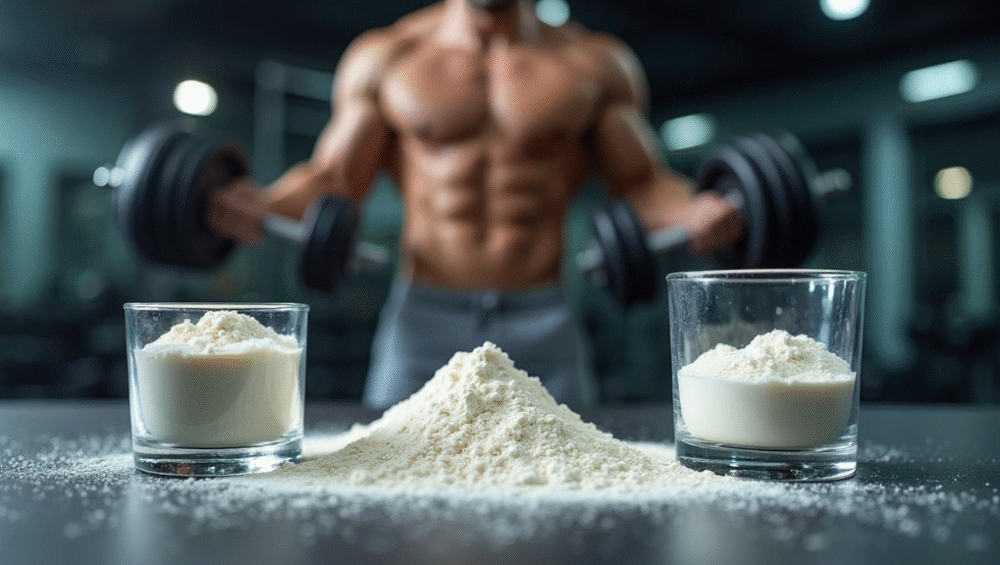Shopping for muscle-building supplements can be confusing, especially with choices between BCAAs and amino acids. Your body needs 20 amino acids, and only 9 of these are essential amino acids (EAAs) that must come from your diet. This difference is vital to understand for your fitness experience. BCAAs are made up of three essential amino acids—leucine, isoleucine, and valine. These amino acids have a unique branched-chain structure that helps them enter your bloodstream quickly during exercise.
The main difference between BCAA and EAA supplements lies in their composition. EAAs give you all nine essential amino acids, while BCAAs provide just three. Your muscle protein synthesis improves by a lot with EAAs, which leads to better muscle growth and recovery. BCAAs are still beneficial, especially when you have post-workout muscle soreness and need immediate energy during training. Research shows that BCAA supplements can reduce the intensity of delayed onset muscle soreness after intense workouts. The question remains – which option works better for your goals? Let’s look at the evidence to help you choose the right supplement for your needs.
Understanding the Difference Between BCAAs and EAAs
Understanding the simple difference between BCAAs and amino acids needs a closer look at how they work in your body and what they’re made of.
What are Essential Amino Acids (EAAs)?
Your body cannot make essential amino acids (EAAs) on its own and must get them through diet. These nine building blocks include histidine, isoleucine, leucine, lysine, methionine, phenylalanine, threonine, tryptophan, and valine. Your body can produce non-essential amino acids internally, but EAAs must come from food or supplements.
EAAs are crucial for several body functions:
- Protein synthesis and muscle development
- Hormone and neurotransmitter production
- Immune system support
- Energy regulation
These compounds make up about 35% of muscle proteins’ essential amino acids. This makes them crucial for anyone who focuses on fitness or muscle development.
What are Branched-Chain Amino Acids (BCAAs)?
BCAAs are a special group of essential amino acids that include leucine, isoleucine, and valine. The name “branched-chain” comes from their chemical structure, which has an aliphatic side-chain with a branch (a central carbon atom bound to three or more carbon atoms).
BCAAs are unique because skeletal muscles metabolise them instead of the liver. This special feature allows them to:
- Give direct energy to muscles during exercise
- Help muscles recover and reduce soreness
- Keep muscle mass during intense training
BCAA vs EAA: Structural and Functional Differences
The main difference between these supplements is their makeup—EAAs have all nine essential amino acids, while BCAAs only have three. A researcher explains it simply: “All BCAAs are EAAs but not all EAAs are BCAAs”.
Studies show that BCAAs alone can boost muscle growth by about 22% compared to no supplements. When combined with other essential amino acids, their effectiveness increases by about 50%. Leucine seems to be the key driver of muscle protein synthesis among the three BCAAs.
EAAs support many body functions because of their complete amino acid profile, while BCAAs focus mainly on muscle metabolism and recovery. This is why many fitness experts now suggest using EAAs instead of BCAA supplements alone to build muscle effectively.
Muscle Building Potential: EAAs vs BCAAs
Muscle protein synthesis shows significant differences between BCAAs and EAAs that affect your training results. Let’s get into how these supplements influence muscle development at the cellular level.
Muscle Protein Synthesis: Complete vs Incomplete Amino Profiles
Building new muscle tissue depends on the net balance between muscle protein synthesis (MPS) and breakdown (MPB). This balance determines whether you gain or lose muscle mass. Your body needs all essential amino acids at the same time to get optimal results. Research shows that incomplete protein sources (like BCAAs alone) can’t fully stimulate MPS because your body needs all nine EAAs to create new muscle protein. Studies prove that BCAAs might trigger muscle protein synthesis but can’t keep it going without the other EAAs.
Leucine’s Role in Anabolism
Leucine stands out as the main anabolic trigger among amino acids. This powerful BCAA activates the mechanistic target of rapamycin complex 1 (mTORC1) signalling pathway—which regulates muscle growth. Leucine stimulates mTORC1 about three times better than other EAAs. Yet multiple studies confirm that leucine alone can’t maintain muscle growth long-term. The full spectrum of EAAs must be present to complete the protein synthesis process.
EAAs for Muscle Growth: Scientific Backing
Research backing EAAs for muscle growth is solid. Free-form EAAs boost MPS better than an equivalent amount of high-quality protein. A 3g dose of EAAs can stimulate MPS just like 20g of whey protein. MPS stimulation associates directly with EAA levels in the bloodstream. Studies show a 34% increase in synthesis rate when EAA levels double. EAA supplements provide all building blocks your body needs. About 80% of ingested EAAs become part of new muscle protein.
BCAAs for Muscle Preservation During Workouts
BCAAs might not build new muscle well, but they excel at preservation. Your working muscles can use BCAAs as direct energy sources during intense exercise. Taking BCAAs before and after workouts may reduce exercise-induced muscle damage. This helps maintain lean mass during caloric deficits. People who train fasted or follow low-calorie diets can use BCAAs to decrease muscle protein breakdown. However, BCAAs alone can’t create an anabolic state where synthesis exceeds breakdown.
When and Why to Use Each Supplement
Strategic timing of BCAA intake can substantially improve their effectiveness for your fitness goals. You’ll get the most value from these supplements by knowing the best time to take them.
Pre-Workout vs Post-Workout Timing
Taking EAAs or BCAAs 30 minutes before exercise offers several benefits. These amino acids help optimise protein synthesis and reduce muscle breakdown during your workout. Research shows that 10 grammes of BCAAs before strength training leads to less muscle soreness and lower muscle damage markers compared to taking them after workouts.
Your body enters a prime muscle-building state right after exercise. Taking amino acids within 30 minutes post-workout helps jumpstart muscle repair. These supplements activate muscle protein synthesis and switch your body back to an anabolic state.
BCAA vs EAA for Caloric Deficit or Fasting
Your body needs more EAAs during caloric deficits. Research shows that a 30% calorie deficit over five days required triple the EAA intake to maintain positive whole-body protein balance. BCAAs work best during fasted training because they help preserve muscle mass without breaking your fast. These supplements contain fewer than 50 calories per serving and don’t trigger large insulin responses, making them perfect for intermittent fasting protocols.
Who Should Use EAAs: Vegans, Athletes, and More
EAA supplements are a great way to get results if you:
- Are vegan/vegetarian and struggle to get complete proteins from plants
- Compete in endurance sports with long training sessions
- Are older and respond better to pure amino acids than mixed foods
- Want to maintain muscle while in a caloric deficit
- Need support during recovery (especially after surgery)
Who Benefits Most from BCAAs?
Athletes dealing with muscle soreness get the most value from BCAAs, especially when starting new training programmes. Weight-class competitors and bodybuilders see great results during cutting phases. Taking these supplements with heavy resistance training on low-calorie diets improved upper body strength by 15.1 ± 2.2kg and lower body strength by 7.1 ± 1.6kg over eight weeks. BCAAs also help reduce mental fatigue during long endurance activities, even though physical performance improvements remain minimal.
BCAA vs Protein and EAAs: Which Offers Better Value?
Smart supplement choices depend on understanding what you get for your money. Let’s get into which options give you the best value for your fitness goals.
Amino Acid vs Protein: Absorption and Efficiency
Your body absorbs free-form amino acids much faster than whole proteins. Whey protein needs 1-2 hours to absorb completely. Free-form EAAs reach your bloodstream in just 20-40 minutes. This quick absorption happens because your digestive system doesn’t need to break down free-form amino acids.
Speed makes a real difference. EAAs boost muscle protein synthesis more than twice as well as the same amount of whey protein. Just 3g of free-form EAAs can build muscle as effectively as 20g of whey protein isolate. This makes EAAs much more efficient per gramme for muscle growth.
Whey protein’s slower release can help you recover better over longer periods.
Cost Comparison: BCAA, EAA, and Whey Protein
BCAAs cost less than EAAs because they contain fewer amino acids. This lower price tag doesn’t mean better value. High-quality EAA supplements work about six times better per gramme than whey protein.
Here’s what you get for your money:
- Whey protein: Best budget option, perfect for daily protein needs
- BCAAs: Middle-range price, works well in specific situations
- EAAs: Costs more but packs more punch per gramme for muscle building
Supplement Stacking: Can You Combine Them?
These supplements work great together to give you complete benefits. Adding EAAs to whey protein improves muscle growth better than whey alone. The right combination might give you the best results.
EAA supplements cause less stomach issues than whey protein because they’re lactose-free and easy to digest. This makes them a great choice if you have a sensitive stomach or feel uncomfortable after protein shakes.
Comparison Table
| Characteristic | BCAAs (Branched-Chain Amino Acids) | EAAs (Essential Amino Acids) |
| Composition | 3 amino acids (leucine, isoleucine, valine) | All 9 essential amino acids |
| Muscle Protein Synthesis | Can stimulate by ~22% compared to no supplementation | ~50% more effective than BCAAs alone |
| Main Function | Metabolised in skeletal muscle | Support broad range of bodily functions |
| Absorption Speed | Direct entry to bloodstream | 20-40 minutes for absorption |
| Best Uses | – Reduces muscle soreness
– Provides immediate energy during training – Preserves muscle during fasted training – Supports cutting phases |
– Maximum muscle protein synthesis
– Overall muscle growth – Complete protein needs – Recovery support |
| Ideal Users | – Weight-class competitors
– Bodybuilders during cutting – Fasted training practitioners |
– Vegans/vegetarians
– Endurance athletes – Older individuals – Recovery patients |
| Value for Money | Lower cost with specific uses | Higher cost with better overall results |
| Best Timing | 30 minutes pre-workout or immediately post-workout | 30 minutes pre-workout or within 30 minutes post-workout |
Conclusion
The battle between BCAAs and EAAs comes down to your specific fitness goals rather than picking an absolute winner. BCAAs contain only three amino acids but are a great way to get benefits like reduced post-workout soreness and preserved muscle during fasted training sessions. EAAs show better muscle-building potential because they contain all nine essential amino acids your body needs for complete protein synthesis.
The right timing makes these supplements work better. You should take either supplement 30 minutes before exercise to optimise protein synthesis and reduce muscle breakdown during training. Post-workout consumption helps quick recovery when your body’s muscle-building state peaks.
Your specific needs determine the choice between BCAAs, EAAs, and whey protein. Whey protein’s benefits include affordability and sustained amino acid release. BCAAs offer targeted benefits for specific scenarios at mid-range prices. EAAs cost more but deliver better gramme-for-gramme results for muscle synthesis.
Look at your fitness goals, dietary restrictions, and budget before making your final choice. Whatever supplement you pick, consistent training, proper nutrition, and good recovery are the foundations of any successful muscle-building programme. The right amino acid supplement gives you that extra edge to maximise results and reach your fitness potential faster.



